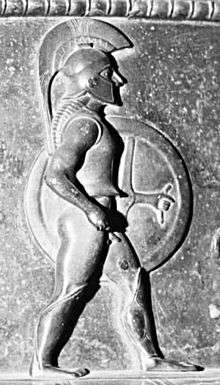Oebalus
In Greek mythology, Oebalus, also spelled Oibalus or Oibalius, (/ˈɛbələs/; Ancient Greek: Οἴβαλος, Oἴvalos) was a king of Sparta.
Family
Oibalus was the son of either Cynortas[1] or Argalus.[2] He was the second husband of Princess Gorgophone and thus son-in-law of the hero Perseus. With her or by the Naiad Bateia,[3] Oibalos fathered Tyndareus,[4][5][6] Icarius and Hippocoon, as well as a daughter, Arene, who married her half-brother Aphareus.[7][8] The nymph Pirene[9] and Hyacinth[10][11] were also called the daughter and son of Oebalius respectively. His grandchildren, the Dioscuri, were usually referred as Oibalids[12] or Oebalidae.[13]
Oebalus was often confused with Gorgophone's first husband, Perieres, son of Aeolus. They were separate people, usually unrelated though Oebalus was sometimes said to be Perieres’ son.[3]
| Relation | Names | Sources | |||||||
|---|---|---|---|---|---|---|---|---|---|
| Hesiod | Apollodorus | Dictys | Hyginus | Pausanias | Lucian | ||||
| Parentage | Perieres | ✓ | |||||||
| Argalus | ✓ | ||||||||
| Cynortas | ✓ | ||||||||
| Consort | Batia | ✓ | |||||||
| Gorgophone | ✓ | ||||||||
| Children | Tyndareus | ✓ | ✓ | ✓ | ✓ | ||||
| Hippocoon | ✓ | ||||||||
| Icarius | ✓ | ||||||||
| Arene | ✓ | ✓ | ✓ | ||||||
| Hyacinthus | ✓ | ✓ | |||||||
| Pirene | ✓ | ||||||||
Notes
- Pausanias, Graeciae Descriptio 3.1.3
- Dictys Cretensis. Trojan War Chronicle, 1.9
- Pseudo-Apollodorus, Bibliotheca 3.10.4
- Hyginus, Fabulae 14.3
- Ovid, Heroides 16.127 ff; not directly named as the son of Oebalus but Helen, the reputed daughter of Tyndareus was called "... a nymph of Oebalus' line ..." which means she was a descendant of the latter through his son Tyndareus.
- Valerius Flaccus, Argonautica 1.420 ff; mentioned that Pollux was called the grandson of Oebalus, the father of their father Tyndareus.
- Pseudo-Apollodorus, Bibliotheca 3.10.3
- Hyginus, Fabulae 78
- Megalai Ehoiai fr. 258, cited in Pausanias, Description of Greece, 2.2.2
- Lucian, Dialogi Deorum 16
- Hyginus, Fabulae 271
- Ovid, Fasti 5.705
- Statius, Thebaid 5.438
